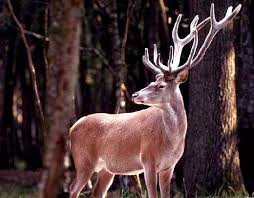In Bree (Limburg province at the Belgian-Dutch border) lives a small herd of deer since 2014.
After the moose (Alces alces) is the red deer (Cervus elaphus) Europe's largest deer.
In the Netherlands it lives in the Veluwe, in the Oostvaardersplassen and in Weerterbos since 2005.
Red deer can be up to twenty five years old, but few animals will be older than fifteen years. In the summer they are reddish brown in winter grayish brown. The belly is white and the tail cream.
 Males are heavy up to 255 kilograms, females up to 150 kilograms. The shoulder height is from 114 to 140 centimeters. The length (head included) is between 165 and 260 centimeters. The tail measuring about twelve centimeters or more.
Males are heavy up to 255 kilograms, females up to 150 kilograms. The shoulder height is from 114 to 140 centimeters. The length (head included) is between 165 and 260 centimeters. The tail measuring about twelve centimeters or more.
The male has in winter well-developed neck mane. They have an antler from 70 to more than 90 centimeters. It may be four to ten kilograms. Young and older deer have smaller antlers, but also nutrition and environment play a role. Globally with the age the antlers and the number of branches increase. Controlled by sex hormones antlers annually shed in the last winter months for old deer, and In March - April for the young animals. Then, the new antlers grow straight up in July. In August, the bark skin begins to itch and they remove it by rubbing the antlers along branches and trunks.
In summer and winter flocks will be formed. Hinds and juveniles together led by a dominant female. Male animals form separate and less structured packs that at the mating season (rut: second half of September to early October) fall apart as they look for the females. Loud roaring the strongest claim to get a maximize herd of hinds (up to 70!). And expel young, non-dominant males.
After a gestation period of 225 to 245 days, late May - June one calf is born with a mottled camouflage coat. The mothers leave the herd for seven to fourteen days. The first two weeks they often leave their calf, hidden in grass or bushes. The young suckle 8 to 9 months and remains 1 year with the mother.
Their diet consists mainly of grasses, herbs and leaves of deciduous trees. In winter dwarf shrubs, saplings and grasses, acorns and beechnuts.
There are several subspecies and hybrids (with: wapiti (Cervus canadensis) and Sika deer (Cervus nippon)).
In addition, there are escaped fallow deer too.
The red deer is distinguished from the fallow deer by its size and the white bottom (white hairy spot on the bottom) without black (out)line. The fallow deer has antlers as a hoe. That's a bit wider and the "parties" are shorter than red deer.
The fallow deer is smaller than a deer and bigger than a roe deer. Its length is 130 to 170 centimeters (head included) and height at withers 85 to 110 centimeters. The fallow deer can weigh 45 to 100 kilograms. The tail is with 16 to 19 centimeters relatively long.
